The Romanian Dacia brand marks a half-century. Part 1 – up to Renault
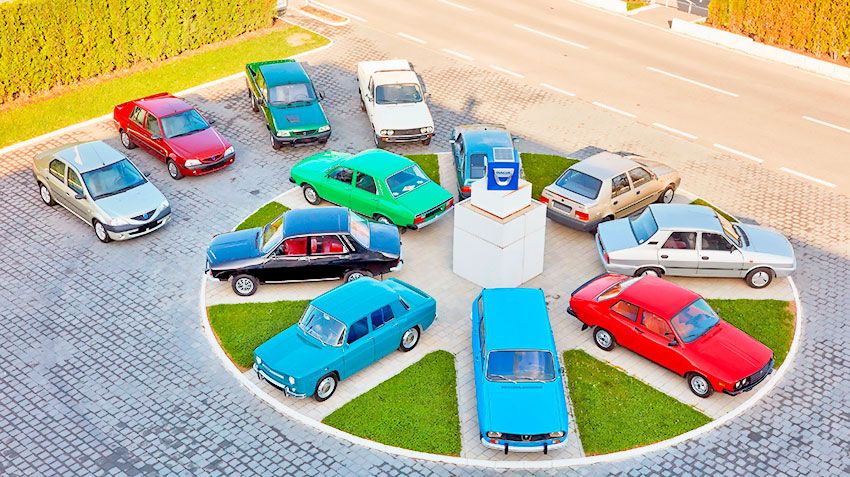
31 July 2018
For half a century, the Romanian automaker has released more than 5 million cars
Only the second of the survivors after the collapse of the Soviet bloc, the Eastern European car brands – the Romanian Dacia, was created almost in parallel with the Soviet VAZ, but in August of this year marks the fiftieth anniversary since the beginning of production of cars.

The head of the Socialist Republic of Romania Nicolae Ceausescu driving the "first" Romanian Dacia 1100
The first car brand Dacia has become a rear-engined minicar Dacia 1100 (Renault R8), allegedly the first copy of which (in fact, this car was No. 75, as it was risky to give the leader of the earliest the collected instance) personally brought out of the Assembly shop with the Great Conductor, "the Genius of the Carpathians", the Communist dictator, Nicolae Ceausescu, to whom this copy and presented. However, until the rumblings of a formidable Romanian revolution of 1989 was far away.
select Difficulty
Meantime (in 1966) the leadership of the Communist party of Romania (RCP) is concerned almost parallel with the Soviet leadership by ensuring the population of cars. As in Brezhnev's USSR in socialist Romania decided not to reinvent the wheel (well, steam train) as are the advanced Western experience in the automobile industry. So was declared the tender for choice of the automobile body styles 4-door sedan, motor a working volume of 1.0 to 1.3 liters and output of 40-50 thousands.
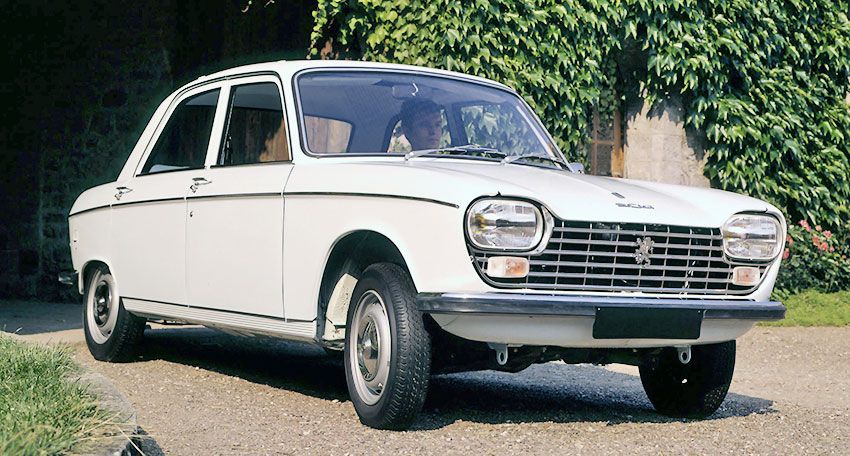
Front-wheel-drive Peugeot 204 could be Dacia, and "Zhiguli", but failed "bourgeois origin"
Initially, the competition was attended by the French Peugeot, the Italian and FIAT "Alfa Romeo", and the English Navy company ("Austin-Morris").
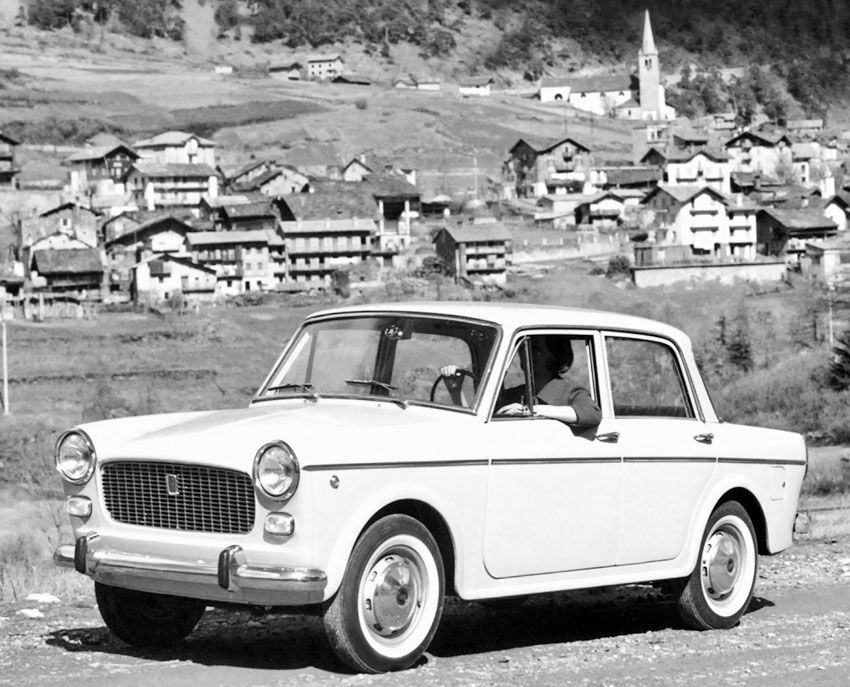
Rear-wheel drive Fiat 1100D was not satisfied with the Romanians, but well suited to the Indians, who published it until 1999 as the Premier Padmini
Accordingly they presented to the competition: front-wheel drive model Peugeot-204 (participated in the Soviet competition for a future model of "Zhiguli"), rear-wheel drive Fiat-1100D (in the late 1970s went to India and was produced until nearly the Millennium),

Rear-wheel drive Alfa Romeo Giulia loved it for the excellent ride quality Italian carabinieri, but the Romanians it came
rear-wheel drive Alfa Romeo Giulia 1300 Austin 1100 front-wheel drive and 4-doors.
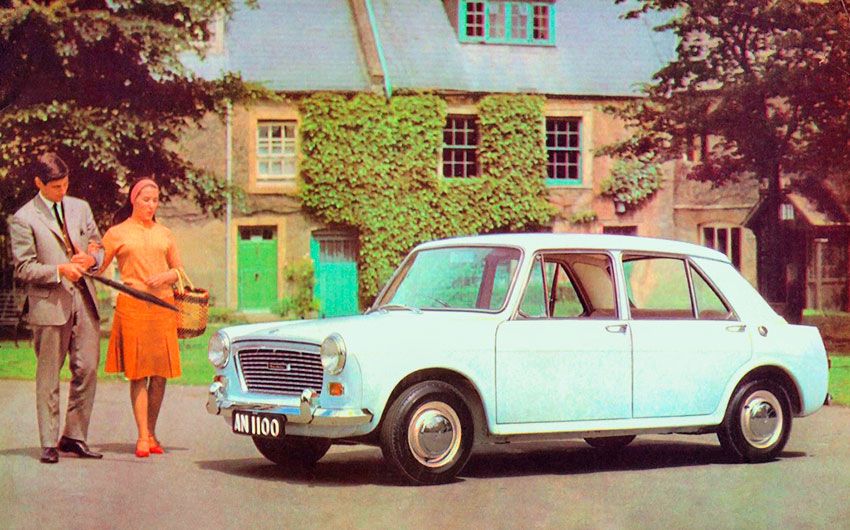
English Austin 1100 (BMC ADO16 project) differed advanced design with a transverse engine and suspension, but it was too expensive for Romania
the Most recent to the competitive marathon was joined by a French state company Renault with a rear-engined model R10. Although the Romanian Commission and announced the winner of the competition initially, Peugeot 204, whose decision was deemed "incompetent," a second vote brought in leaders English a runabout, but... big politics intervened. The fact that, in August 1966 year legendary father of the Fifth French Republic, General Charles Degaulle visited with official visit to Romania and... in front of this poor (but oil!) the Balkan country has opened wide prospects for adoption of Western technology and capital, than the leadership of the CPP and did not fail to take advantage. President Charles Degaulle, so to speak, brought the Romanians "the beak" the project is not utilized in the production of the Renault R12 sedan (later a station wagon). Political leadership of the socialist Romania, exactly like their colleagues in the USSR in the face of the Brezhnev Politburo of the Central Committee of the CPSU (made italianskoe offer FIAT-y), made it a political choice in the spirit of the eternal Romanian Francophonie – to take the French model R12 have even Western, but still of concern, and it was important, so as to cooperate with a purely "bourgeois" firms Peugeot and BMC country of the socialist camp was the ideological and propaganda reasons somehow neprilichnye. So, as the Romanian people's car and confirmed this, however, is quite advanced at the time the FWD model with a notchback sedan and the engine capacity of 1.3 liter capacity of 54 HP.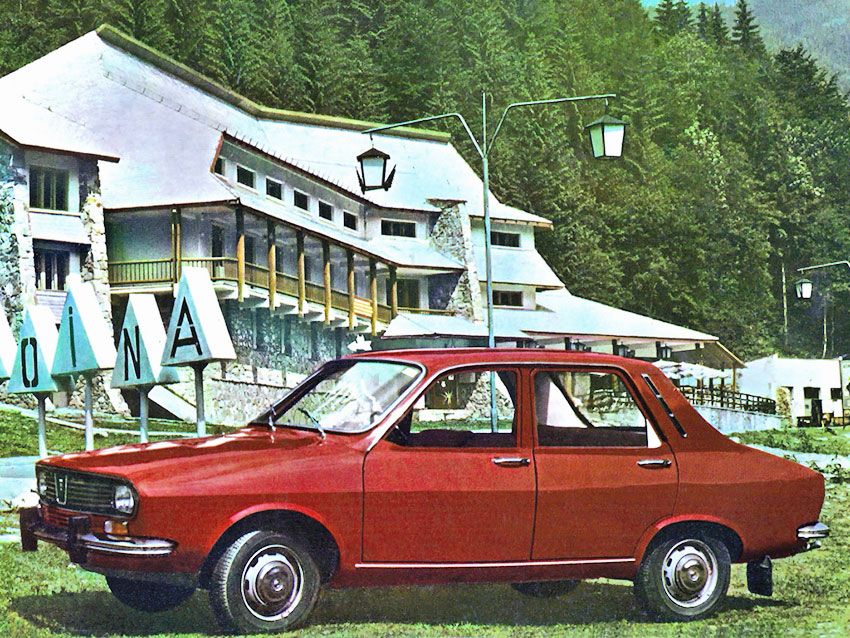
For the early 1970s Dacia 1300 and Renault R12 differed just dandified design and quite advanced front wheel drive design (albeit with a longitudinal engine layout)
Moreover, the release of it began in the West and in the socialist camp – the case, at that time unique. By the way, the model Renault R12 was well sold in France, exported and produced under license in a number of countries on all continents (especially on a large scale was the production in Turkey at the plant of Oyak-Renault, amounting to a total of 0.7 million for the years 1971-1999).

To begin production at the plant near Pitesti Dacia had yet with a more simple rear-engined model 1100 (Renault R8)
Another issue is that experience of conveyor production of cars with the Romanians (as, indeed, and neighbors Bulgarians) there was no local copy of the Soviet jeep GAZ-69 (ARO) and the truck ZIS-150 doesn't count. However, both sides (French and Romanian) is well aware of the "warm-up" model. For example, in the USSR, a similar conflict has allowed the delivery at the initial stage of development of VAZ-2101 "Zhiguli" skilled Italian assemblers and engineers of the Fiat. In Romania built in record time (18 months!) car factory Dacia in Mioveni city (until 1996 known as Colibasi), 15 km from Pitesti, as a "warm-up" first, almost chose the prestigious R16 world's first two-volume 5-door hatchback, but the time came around that unskilled local Assembly and cost of Assembly vehicle sets can ruin a good idea at the root (something like this a couple of years later and went into the next BNR). Selected was the cheapest at that point in the line Renault model sedan – the rear-engined R8, of course, the crossover in Romania at the Dacia 1100.

What was possible in Romania failed in Bulgaria (here the model R8 was released in 1967-1972 and had turned from poor build quality)
Its Assembly plant Automobile Dacia S. A. began in August 1968 (two weeks before the release of the complete car under the strict control of the French party were the first power unit was assembled) and lasted until 1972. In all there were 37 546 units of such machines with 1.1-liter 46-horsepower motor accelerates it up to 138 km/h. of Course, the Dacia 1100 was not different for the better nor the build quality nor the dynamics, nor the vastness of the cabin, but it was cheap and off-road on the mountain roads of this poor Balkan country. Not surprisingly, Dacia 1100, despite the cessation of production in 1971, long revolved in the secondary market of Romania.

Today, however, this Oldtimers on the roads of his homeland, is already extremely rare, although respect
The release of the second and main model Dacia front – wheel drive sedan 1300 (Renault R12) began in August 1969, and the premiere models for Renault Dacia 1300, R12, and passed, almost simultaneously, respectively, in Paris and Bucharest. From 1971 limited edition began to produce the "establishment" version of the Dacia 1300 Super Lux (exclusively in black and dark blue colours) with the top bundle, which ordinary people did not sell. However, "the Communist boyars" have always been able to grab a piece better, and this was a good EPS even against not bestowable the nomenclature of the leaders of other socialist countries. So, at the end of the license agreement in 1978 year, the company Renault, firmly hoping for a continuation of the license agreement with Dacia, actually on a tolling basis set in the CPP party kits more modern models R18 (the successor to the legendary by their strength and endurance series R12), which then almost completely went to pull. In 1980, despite the failure of negotiations on the extension of the joint venture, Renault has put in the CPP about 2 thousand kits have been specially adapted to the needs of the governing party organs and the Romanian secret service (Securitate was called, if anyone remembers) full-size hatchbacks R20, which was also released only in black or dark blue color.
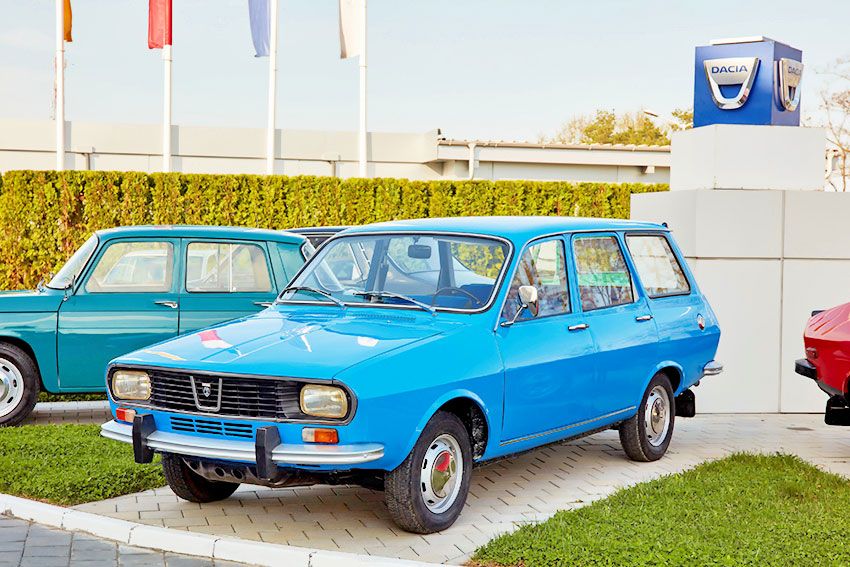
Universal Dacia 1300 Kombi was more strength and endurance than the sedan
Since 1972 has been the release of the Dacia 1300 Kombi universal (R12) Break, due to the reinforced floor base and rear leaf spring suspension, on the basis of which in 1975 issued a commercial pickup truck model 1302 (capacity 550 kg),which produced until 1982.
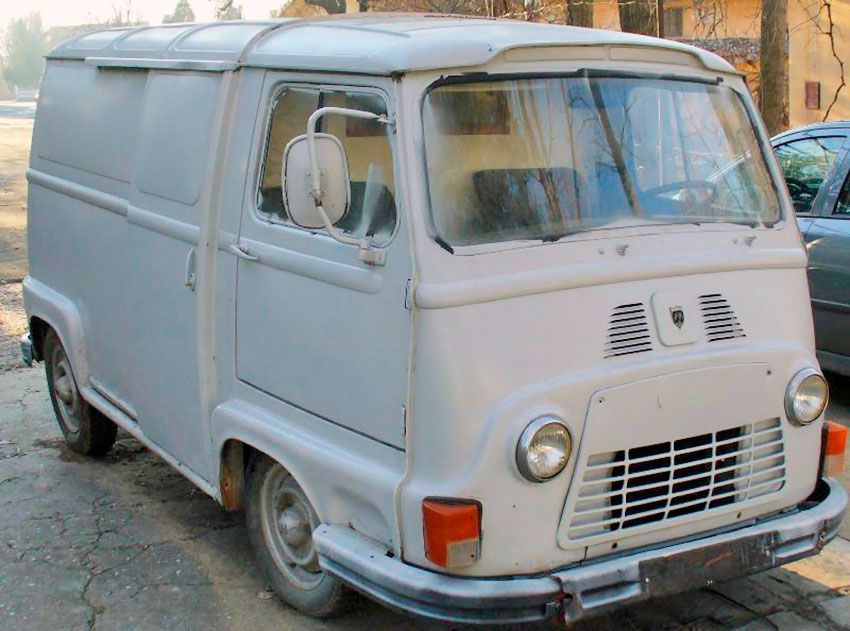
Van Dacia D6, produced in 1975-1978 was curtailed due to competition with other plant model
In 1975-1978 in small batches produced front-wheel drive van Dacia D6 – a copy already coming down from the stage model of Renault Estafette. However, this attempt was not so covered, and so as not to create competition seater RWD van TV12/TV14. Vans Dacia D6 used basically the post office of Romania.
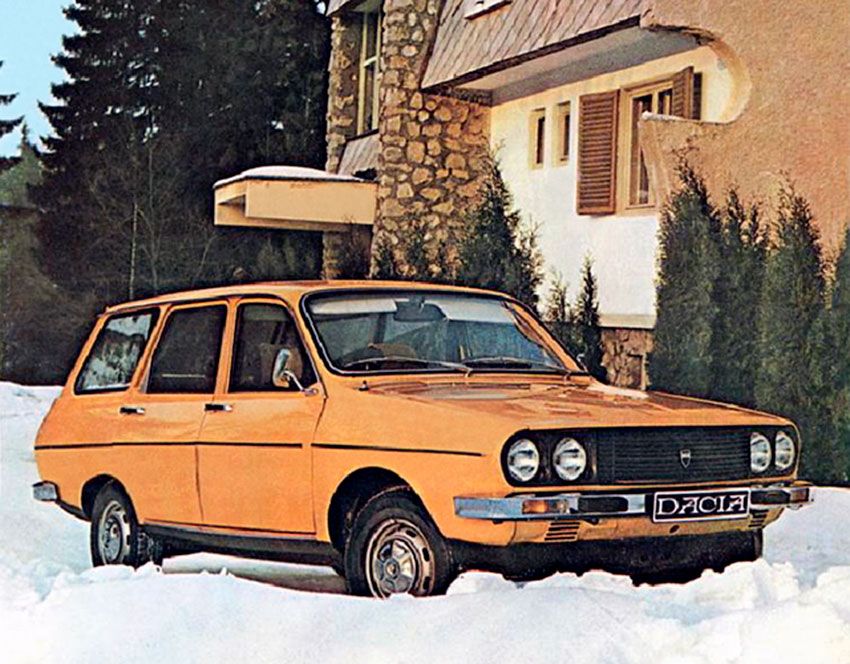
In 1980, Dacia second series (1310) received dual round headlights and some other improvements
Accordingly, after 1977, the 1300 series has already become a 100-percent localized in Romanian, but the technical development of Dacia actually stopped, although minor improvements in design are still made. So, in 1980, after the restyling of the French twin R12 sample 1975 Dacia 1300 model underwent a facelift with the replacement of a rectangular headlight to dual round (Dacia 1310), increase the rear lights and some modernisation on the interior. Some time later there was the choice of the more economical 1.2-litre Dacia (1200) or more torquey 1.4-liter (Dacia 1410) motors, but the attempt to integrate the diesel failed. In the early 1980s, Dacia and LADA widely exported not only in the CMEA countries and the third world, but even in Benelux, UK, France, Germany and Canada.
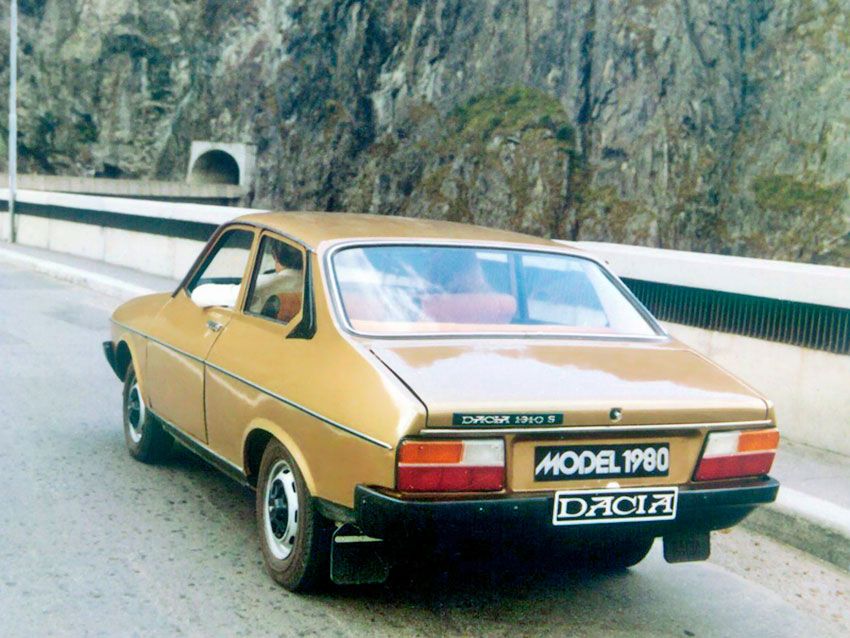
On the basis of Dacia even tried to release a coupe, but it was limited to a small party for the Romanian "Golden youth"
In the 1980s, the limited quantities produced of the model 1310's with a two-door coupe and a sport model 1410 Sport to compete in the classic rally.
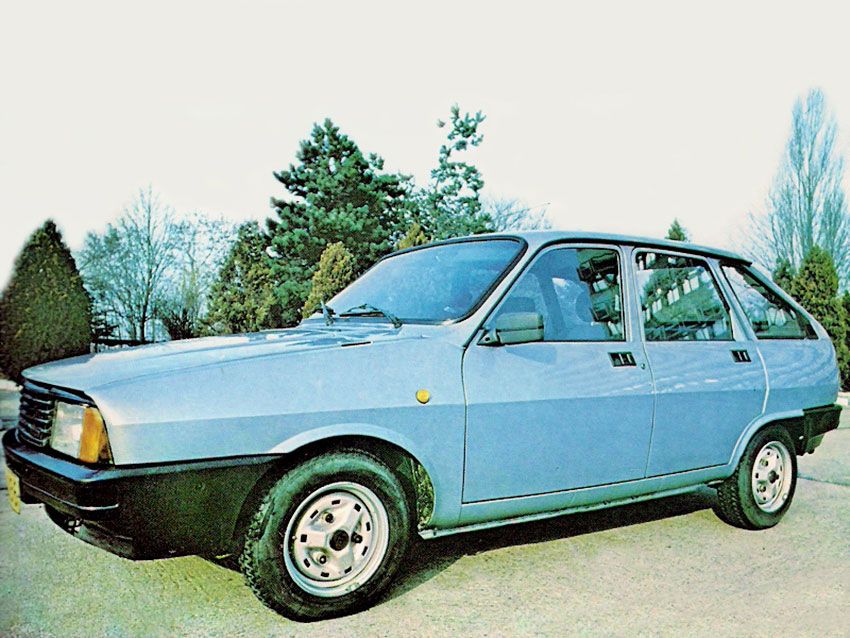
The hatchback Dacia 1320 was one of the last among these models of the Soviet bloc
In 1989 Dacia 1310 has undergone another facelift with the replacement of the four round headlights on a few large, rectangular headlamps. In 1988, the line also added a five-door hatchback Dacia 1320, however, subjected to a Western media shaped stigma. According to enlightened Western media to mold a new model on an archaic platform, was clearly a dead-end path, although, in General, the hatchback Dacia corresponded to the wave of fashion for such a two-volumetric body: LADA Samara (VAZ-2108/-2109), 106 Favorit Skoda, Zastava (Yugo) Florida, ZAZ Tavria (ZAZ 1102) to reach the countries of the socialist camp just in time for the second half of the 1980s.
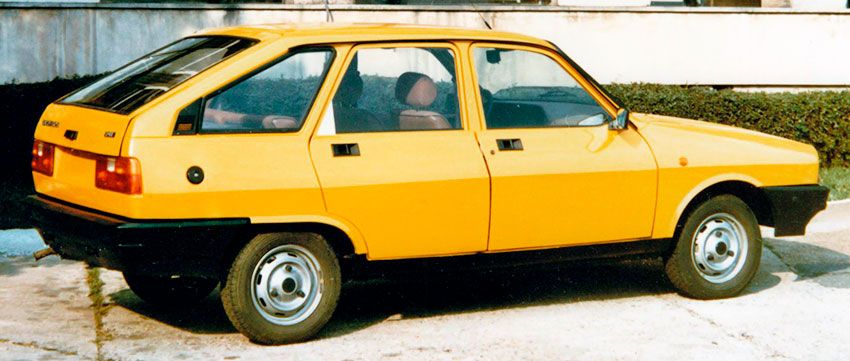
The hatchback Dacia 1325 Liberta ("Freedom") went very low mintage
In 1990, the model was upgraded and became known as 1325 Liberta ("Freedom"). The issue of "Freedom" lasted until 1996 (together with earlier model 1320 made a total of 7800 units) when it finally replaced the original model Nova.
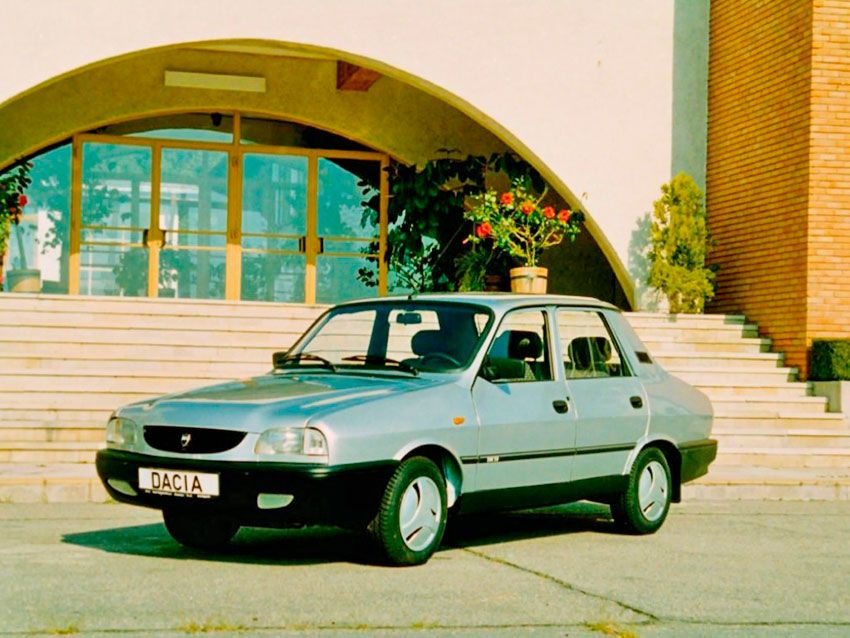
With the latest restyling, conducted with the participation of Renault Dacia 1310 series lived to the end of production in 2004
Traditional sedan and wagon series 1310, however, have been another facelift, receiving a new exterior front and rear with surround plastic bumpers, upgraded interior and new powertrains production Renault. In this form they were produced until July 2004, when they lost the place on line of the newest series Logan. There were produced 1 million 953 thousand 730 cars series 1300-1410.
Real pickup should be rear-wheel drive

Rear-wheel drive pick-up Dacia 1304 Drop Side with three drop sides
The requirements of the external market led to the creation in 1981 of a full-fledged rear-wheel drive pick-up Dacia 1304, capacity 1150 kg, in versions Pick Up with smooth sides with single flange along the body and Drop Side drehbarem body (since 1983). In 1984-2003, he also produced an export version 1304 King Cab with an extended two-door 4-seater cabin.
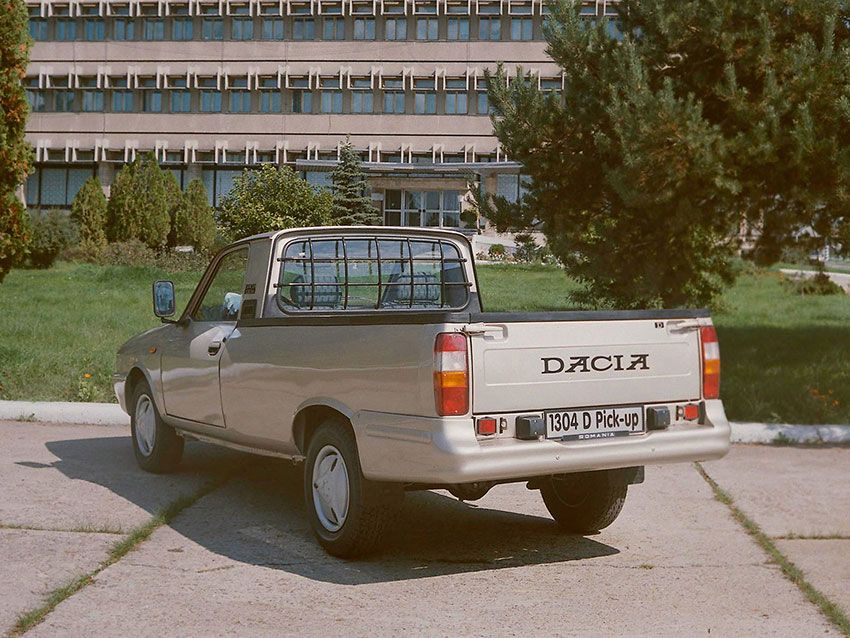
Rear wheel drive pickup must be rear-wheel-drive (pictured model 1304 D Pick Up with smooth sides)
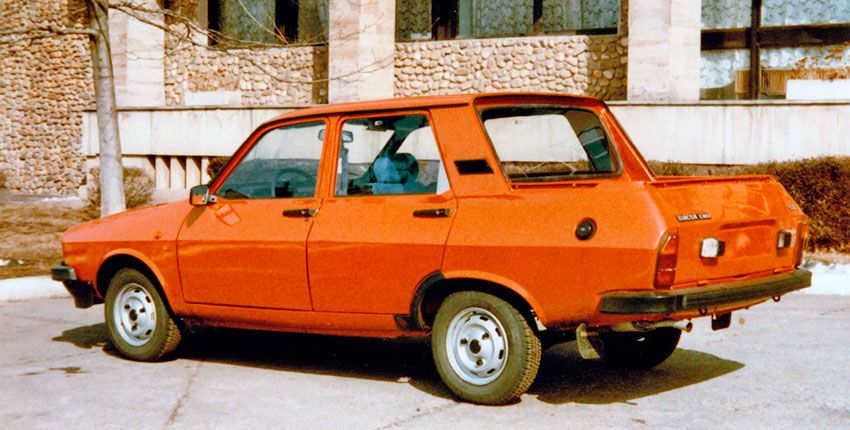
The amusing front-pickup truck Dacia 1309 was actually a wagon with trimmed rear roof, but could carry up to 450 kg of cargo
Export was produced in 1992-1998 original model 1309 double cab (actually a station wagon with the back cut off part of the roof), a capacity of about 450 kg.
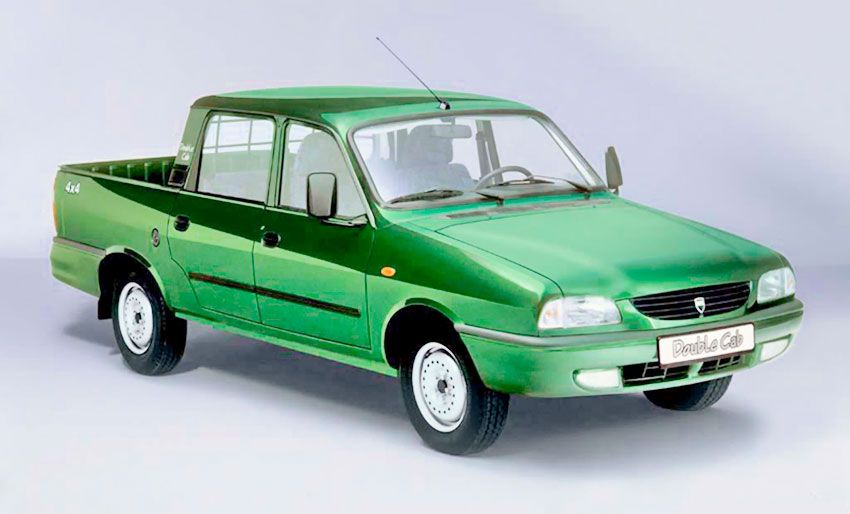
Pickup Dacia 1307 double cab, Yes, even in the 4x4 version looked much more solid and stayed on until the end of 2006
A full two-cabin pickup 4-door cab model 1307 appeared in 1992, first in rear-wheel drive version, and from 1999 and an all-wheel drive as the model 1304 is produced to the end of the series in December 2006. By the way, in 2002-2006 pickups have also installed diesel Renault F8Q.

The presence of a full drive, however, not much has improved the market position of the pickups Dacia (pictured odnoimennaya model 1304D with a 1.9-liter diesel Renault)
a Short flight "Swallows"
In parallel with the base model 1988-1991 factory in Timisoara produced urban micro-car, only 500 Dacia Lăstun ("Swallow") weight 590 kg due to the fiberglass body with a 499-CC of 22.5-horsepower two-cylinder engine, however, consuming only 4 liters/100 km and accelerates the baby only up to 106 km/h.
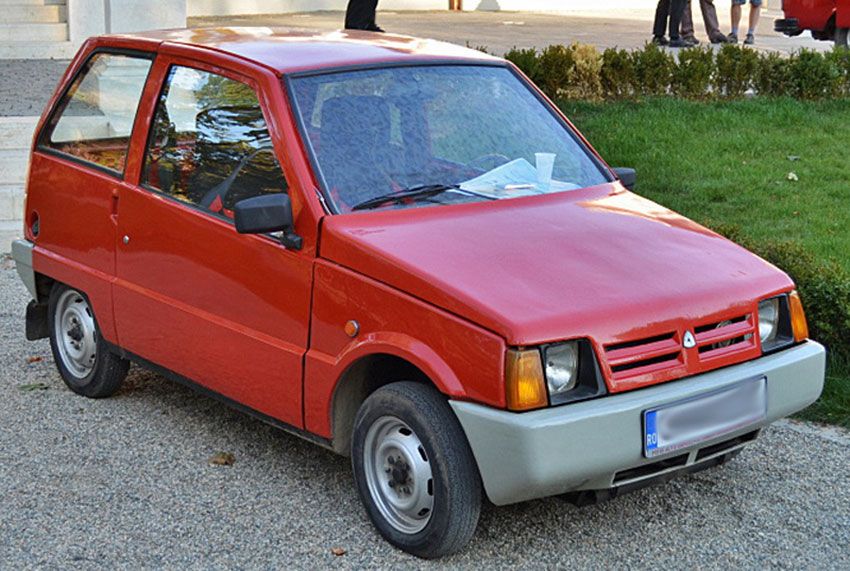
Baby Dacia 500 Lăstun ("Swallow") was not set the quality and price and was ignominiously driven from production
This is even smaller in dimensions (2,95х1,41х1,35 m base 1,92 m) than the Soviet Oka (VAZ-1111) machine, remember quality level "below a plinth", which, however, stirred a revolution in the country, is understandable, but, more importantly, however, it is this, coupled with high price led to the closure of the plant in Timisoara in 1992, at the request of the government of Romania: "in Order not to embarrass the Romanian automotive industry by its low quality". All were produced 6532 "Swallows".
Not a new Nova
Another not-too-successful local development model was Dacia Nova. Its development was started according to some sources in 1983, the other in 1985, but in any case to start in the series didn't have the money and the conveyor this model, which evil tongues guess replica not 309 Peugeot, not Renault 11, got only a decade later – in 1995.
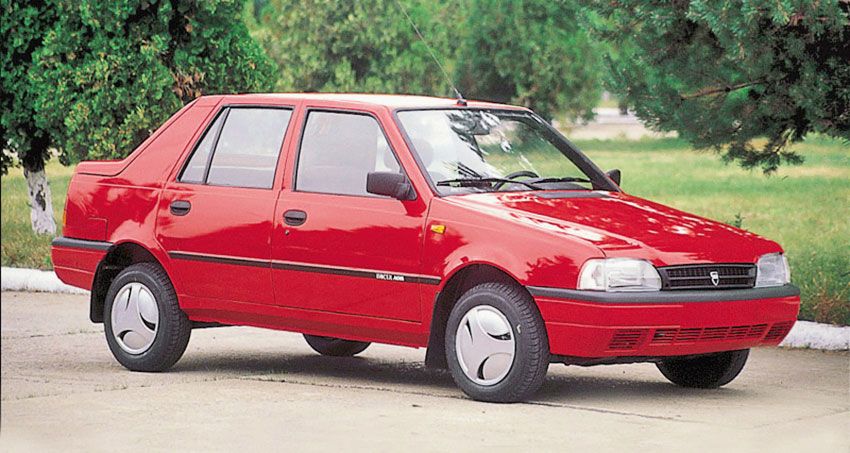 First independent development of Dacia is a hatchback Nova too long to get the pipeline
First independent development of Dacia is a hatchback Nova too long to get the pipeline
The quality of the first series, offered, by the way, in the form of a two-volume hatchback model Nova 523 and two and a half volumes liftback Nova 524, was as usual, "at the level of the floor," plus, packaged with this older model carbureted 1.6-liter engine and low quality materials of furnish of salon. Carburetor engine, however, managed to replace the petrol engine with mono injection from Bosch, but diesel from Peugeot was too expensive, and that is called go.
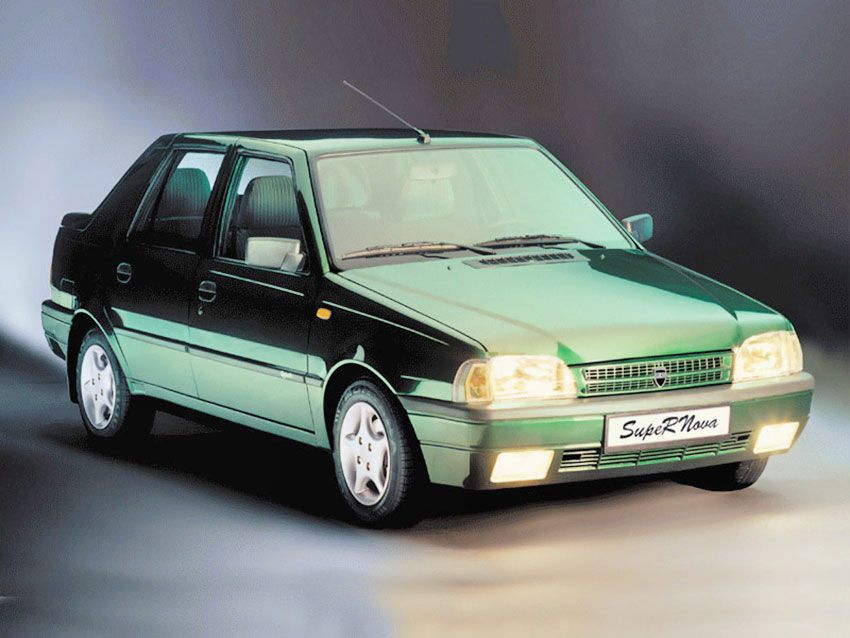
The upgraded Dacia SupeRNova learned the power unit Renault and immediately became a bestseller of the local market
Improve business with quality managed only two receptions since coming to the leadership of Dacia group Renault, which, I must say, not broke off in the early 1990s, the more attractive the prize, the Czech firm Skoda, departed rival – the Volkswagen Group. As in the strategic plans of the French the company was the issuance of a special extra low-cost model for emerging markets (future Logan) at a price of 30 000 FRF, i.e., French francs, became after the introduction of the Euro, respectively, €5000, the French had to settle for third-rate Romanian manufacturer, which at that time so messed his image, what is called, its brand name language is not turned even the journalists of those countries where Dacia cars and almost did not get (like Russia). Exports at this time are almost non-existent and was limited to only neighboring to Romania countries. In 1999, Renault S. A. is consistently first bought a 51% stake in Dacia, then brought its stake to 73% and began in earnest to raise the technical level of the line of Dacia models, so instead of Nova was running SupeRNova model the main difference of which was imported the power plant of 1.4-liter engine Renault J7 (Euro-2) and 5-speed gearbox from the Clio model. Interestingly, all three years of production this model was the best-selling Romanian car, reaching a peak in 2002 with a share in a quarter of the local market.

Latest original Dacia was the model of Solano, modernized under the leadership of Renault,but it quickly gave way to a new model of Logan on the world platform B0
In March 2003 it was followed by more serious restyled update of the exterior of the front end and the introduction of more modern motor 1.4MPI already Euro-3 standard, supplemented by diesel 1.9 D. Model called Solenza and released before July 2005 (by the way, a short time it was collected, and the Ukrainian ZAZ), but that was the Swan song of the independent development of Dacia, which, in 2004, mastered the production of the latest "extra-budgetary" or the so-called Low Cost Logan model, which began triumphantly stepping across continents, in a relatively short time returning Dacia positive reputation of the manufacturer is enough quality affordable cars, but that's another story.
to be Continued...
.
|
|
|
Element was not found.








